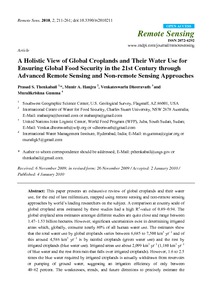A Holistic View of Global Croplands and Their Water Use for Ensuring Global Food Security in the 21st Century through Advanced Remote Sensing and Non-remote Sensing Approaches
Abstract
This paper presents an exhaustive review of global croplands and their water use, for the end of last millennium, mapped using remote sensing and non-remote sensing approaches by world’s leading researchers on the subject. A comparison at country scale of global cropland area estimated by these studies had a high R2-value of 0.89–0.94. The global cropland area estimates amongst different studies are quite close and range between 1.47–1.53 billion hectares. However, significant uncertainties exist in determining irrigated areas which, globally, consume nearly 80% of all human water use. The estimates show that the total water use by global croplands varies between 6,685 to 7,500 km3 yr−1 and of this around 4,586 km3 yr−1 is by rainfed croplands (green water use) and the rest by irrigated croplands (blue water use). Irrigated areas use about 2,099 km3 yr−1 (1,180 km3 yr−1 of blue water and the rest from rain that falls over irrigated croplands). However, 1.6 to 2.5 times the blue water required by irrigated croplands is actually withdrawn from reservoirs or pumping of ground water, suggesting an irrigation efficiency of only between 40–62 percent. The weaknesses, trends, and future directions to precisely estimate the global croplands are examined. Finally, the paper links global croplands and their water use to a paradigm for ensuring future food security

